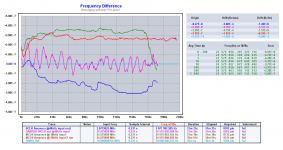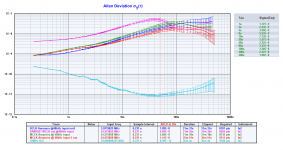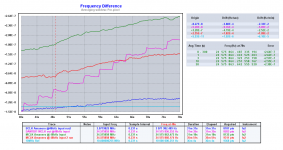I sincerely doubt patents play any significant role in the development of audio equipment. They mostly serve as cheap advertising and self promotion.
Somewhere buried in this thread was a discussion about digitally calibrating the linearity. Not sure if this would have a significant audible impact. I have had boards using resistors with different tolerances and the audibility, at least to me, seems very questionable.
Somewhere buried in this thread was a discussion about digitally calibrating the linearity. Not sure if this would have a significant audible impact. I have had boards using resistors with different tolerances and the audibility, at least to me, seems very questionable.
The Holo Audio May uses R2R trimming and states it is patent pending - given there's prior art that has now expired, I wonder how valid that claim is. It does open the door for other R2R manufacturers to review the patent positions and possibly offer R2R trimming.
The R2R trimming would help the linearity (a weak spot in the soekris and others).
That patent doesn't matter, just some generic principles.... And the issue have been discussed a couple of times, but apparently nobody read the whole thread anymore, it have become pretty long.... And my DACs are all Sign Magnitude, which is not that sensitive to resistor mismatch and are level linear down to -140 dB....
I have looked at active error correction by measuring the R-2R network, even have space for the hardware on my dam1021 test fixture, but don't believe the advantages are worth it so I have never tested it. A dam1941 have typical THD at around 0.0035%, which most people consider way below the hearing threshold. So why waste resources trying to improve that ?
You also have to consider thermal drift and long term drift, requiring you to calibrate at each power up, measure temperature and have multiple correction tables.... And then you have to use some valuable FPGA resources, like memory blocks, which I would rather use for longer filters....
The only real advantage would be cost, you could use cheap 0.1% resistors and then calibrate the DAC at each power up.... Those precise but slow ADC are not that expensive.
hi soren
DAM 1021 DIY DAC new version 6 will be released when.
from which website the consumer will be selling.
good work.
sorry for the bad english.
What dam1021 version 6 ? We are currently of of dam1021 stock, but will make more soon....
Please see Soekris Engineering ApS, Ordering
That patent doesn't matter, just some generic principles.... And the issue have been discussed a couple of times, but apparently nobody read the whole thread anymore, it have become pretty long.... And my DACs are all Sign Magnitude, which is not that sensitive to resistor mismatch and are level linear down to -140 dB....
I have looked at active error correction by measuring the R-2R network, even have space for the hardware on my dam1021 test fixture, but don't believe the advantages are worth it so I have never tested it. A dam1941 have typical THD at around 0.0035%, which most people consider way below the hearing threshold. So why waste resources trying to improve that ?
You also have to consider thermal drift and long term drift, requiring you to calibrate at each power up, measure temperature and have multiple correction tables.... And then you have to use some valuable FPGA resources, like memory blocks, which I would rather use for longer filters....
The only real advantage would be cost, you could use cheap 0.1% resistors and then calibrate the DAC at each power up.... Those precise but slow ADC are not that expensive.
Simple, to please the measurement crowd, who will buy based on what they see on AS, it would automatically mean more sales, treat it like a business decision rather than one that makes complete sense. It might actually cause a stir when perfect measuring dac still sounds different to the latest & greatest topping.
Last edited:
I sampled, at 5 samples/sec, the frequency of several clocks of the the DAM1021 (of those which are easily accessible at the Normunds input board).
As stated in this tread before, the variations in these time scales here are probably irrelevant for audio, but nether the less I think this is interesting as this are direct measurements of something we before only had indirect clues. I sampled:
The DAM-FPGA master clock (which is half the SI 514 frequency)
The I2S BCLK (from the Amanreo USB interface) which is measured by the DAM as input for the frequency adjustment.
The I2S MCLK (from the Amanreo USB interface).
The different measurements were made one after the other as the frequency counter has only one channel. So there are no relation between individual "bumps" in the different traces.
We see the DAM-FPGA master clock (pink trace) has some oscillations around the frequency it is tracing. But the I2S clocks have sometimes deviations of similar magnitude.
The first plot is frequency over time, the second the Allan deviation of the samples.


Zooming in, one even sees the stepped adjustment of the DAM-FPGA master clock.

The light blue trace is the sampling of a decent 10MHz OCXO, just to illustrate that we are away from the limits of measurement.
As stated in this tread before, the variations in these time scales here are probably irrelevant for audio, but nether the less I think this is interesting as this are direct measurements of something we before only had indirect clues. I sampled:
The DAM-FPGA master clock (which is half the SI 514 frequency)
The I2S BCLK (from the Amanreo USB interface) which is measured by the DAM as input for the frequency adjustment.
The I2S MCLK (from the Amanreo USB interface).
The different measurements were made one after the other as the frequency counter has only one channel. So there are no relation between individual "bumps" in the different traces.
We see the DAM-FPGA master clock (pink trace) has some oscillations around the frequency it is tracing. But the I2S clocks have sometimes deviations of similar magnitude.
The first plot is frequency over time, the second the Allan deviation of the samples.


Zooming in, one even sees the stepped adjustment of the DAM-FPGA master clock.

The light blue trace is the sampling of a decent 10MHz OCXO, just to illustrate that we are away from the limits of measurement.
The only real advantage would be cost, you could use cheap 0.1% resistors and then calibrate the DAC at each power up.... Those precise but slow ADC are not that expensive.
Save on components by adding some complexity for an overall cost saving.
All depends on the numbers.
What dam1021 version 6 ? We are currently of of dam1021 stock, but will make more soon....
Please see Soekris Engineering ApS, Ordering
good Morning MR Soekris .
i want to buy a "dam1021-12" 0.01% / 0.02% resistor version "
i sent few messages in november and december to (( info@soekris.dk )) , but no answer … how to do an order to europe ( France ) ?
thank you for your help
jijijosuke
With the only intention of telling it like it is, Soren made many good choices in his designs, and the community has come to recognize most of them over time. But Soren's being closed to the possibility that fundamentally fixing the resistor mismatch, and by extension the THD problem, can make an audible difference and have practical value, while believing his R2R system to be overall superior to DS counterparts without scientific (i.e. double-blind test) evidence, makes no sense to me. I used to believe that THD doesn't matter after a certain point, based on ABX testing results, but I'm not so sure anymore. After all, there're plenty of double-blind tests that found no audible difference among different DACs, not that I'm drawing a close parallel - reasons to question the intended conclusions of the test results might well be different, and one of the claims might well be true despite the other. With that out of the way, I find it questionable to dismiss an exploratory project that could very well beat DS at their own game once and for all - a game that many professional engineers have dedicated much of their lives to playing, not least when there is little uncertainty to its technical feasibility.
As I mentioned previously, I hold no ambition of persuading or encouraging Soren to undertake any technical endeavor at this point. I merely call to question his judgment on the matter. Whether it'll be a sound business decision, I'm not in a position to know. I'm also certainly not suggesting that we attempt any remotely plausible improvement proposed, hardware or software. But given the existence of this 869-page thread, and everyone's continued interest in it, I find it preposterous that Soren dismisses the resistor compensation project out of hand.
As I mentioned previously, I hold no ambition of persuading or encouraging Soren to undertake any technical endeavor at this point. I merely call to question his judgment on the matter. Whether it'll be a sound business decision, I'm not in a position to know. I'm also certainly not suggesting that we attempt any remotely plausible improvement proposed, hardware or software. But given the existence of this 869-page thread, and everyone's continued interest in it, I find it preposterous that Soren dismisses the resistor compensation project out of hand.
Actually a 2006 compensated R2R ladder patent already exists: US7336211B1 - Resistance compensated DAC ladder
- Google Patents
Temperature compensated R2R already exist but this also was granted: US Patent for Digital-to-analog converter and method for digital-to-analog conversion Patent (Patent # 10,511,321 issued December 17, 2019) - Justia Patents Search
So as Soren has said - there's already a minefield out there, however how much you'd hear in terms of deviation of resistance.
The DAC I'm looking to put together includes a Soekris R2R with a IanCanada HP-2. The output THD is unlikely to really make a big difference given the amp. All depends where in the spectrum the distortions are.
- Google Patents
Temperature compensated R2R already exist but this also was granted: US Patent for Digital-to-analog converter and method for digital-to-analog conversion Patent (Patent # 10,511,321 issued December 17, 2019) - Justia Patents Search
So as Soren has said - there's already a minefield out there, however how much you'd hear in terms of deviation of resistance.
The DAC I'm looking to put together includes a Soekris R2R with a IanCanada HP-2. The output THD is unlikely to really make a big difference given the amp. All depends where in the spectrum the distortions are.
good Morning MR Soekris .
i want to buy a "dam1021-12" 0.01% / 0.02% resistor version "
i sent few messages in november and december to (( info@soekris.dk )) , but no answer … how to do an order to europe ( France ) ?
thank you for your help
jijijosuke
Did you manage to get in contact with him?
I have also sent a few emails but got no answer in more than a month...
I'm currently out of stock of both the dam1021-05, dam1021-12 and dam1941-12, I do have the dam1921-02 in stock.
I'm working to make more, expect to have stock of everything again sometimes in late February....
I receive many emails, and try to answer everybody, as it says on my website:
We do our best to respond to emails and phone calls in a timely manner, but please note that due to the small size of the company, we might not be able to respond immediately. If you feel like it takes to long time, please resend your email.
The best is to resend, also, please do not try to contact me though forums as I can't connect usernames to emails....
I'm working to make more, expect to have stock of everything again sometimes in late February....
I receive many emails, and try to answer everybody, as it says on my website:
We do our best to respond to emails and phone calls in a timely manner, but please note that due to the small size of the company, we might not be able to respond immediately. If you feel like it takes to long time, please resend your email.
The best is to resend, also, please do not try to contact me though forums as I can't connect usernames to emails....
I'm currently out of stock of both the dam1021-05, dam1021-12 and dam1941-12, I do have the dam1921-02 in stock.
I can wait for the dam1941-12 to be restocked - I will order once my new job is signed (they approached me so it seems a formality) so that is likely to be feb time.
Hello o have tryed TNT filters from 1833post. Before i have party pack nos filters. What can i say i think i hear difrences in lokalization,more fluid, dynamic and culture, but i have heard that filters are done for 44 and 48khz, but im sure when i ups to 352/384sound get more open, more details , more sound around sound . somethink like harmonics. Details in background. Why?
Im compering same 44khz rocording,only fs are ups to 352800hz. Yours filter are work properly on 352/384 fs? I can say that on ups sound is better . I have fully modded 1021dam with a123 lifopo4 batery power suply connected with no i2s isolators to xmos 764khz usb with no isolators. And have fifo reclocer from diyinhk.com rest of transport is nuc 5i7 with roon core and raspberry pi3b with moode audio, all powered by very good lps.
- Home
- Vendor's Bazaar
- Reference DAC Module - Discrete R-2R Sign Magnitude 24 bit 384 KHz